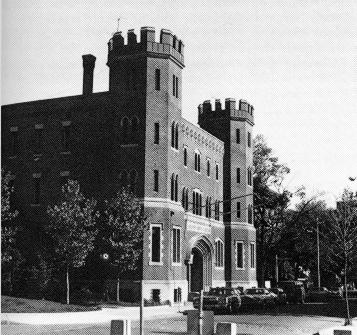VIPs Visit Salem
- Home
- About Salem »
- Salem Tales »
- VIPs Visit Salem
‘VIPS’ Visit Salem
For a small city of just under 40,000 people, Salem has attracted more than its share of famous visitors over the past century.
William Howard Taft, who spent all four summers during his presidency on the Beverly coast, spoke at Ames Hall in the Salem YMCA in 1916, and was once involved in an auto accident at Boston and Essex streets.
 One of the best remembered of Taft’s public appearances in the Witch City took place Oct. 4, 1912 at the Salem Armory on Essex Street. The occasion was the unveiling and dedication of a plaque honoring the famed 1st Heavy Artillery, Massachusetts Volunteers. Before moving to the adjacent Essex Institute for the actual unveiling, Taft addressed a crowd of more than 3,000, including a contingent of veterans of the regiment who had served in the Civil War.
One of the best remembered of Taft’s public appearances in the Witch City took place Oct. 4, 1912 at the Salem Armory on Essex Street. The occasion was the unveiling and dedication of a plaque honoring the famed 1st Heavy Artillery, Massachusetts Volunteers. Before moving to the adjacent Essex Institute for the actual unveiling, Taft addressed a crowd of more than 3,000, including a contingent of veterans of the regiment who had served in the Civil War.
Presidential hopeful Theodore Roosevelt also made a brief appearance in Salem in 1912. On April 29, the former president and hero of the Spanish-American War stopped on a whirlwind tour of Massachusetts that would take him to 15 communities in a single day.
Roosevelt arrived by train from Boston and was driven to a platform in Town House Square. In a brief address, he urged the assembled throng of nearly 3,000 to join him in standing up to the special interests that he claimed controlled American politics.
His remarks were repeatedly interrupted by the noise from trains passing through the tunnel beneath the square.
“I don’t find Salem a quiet town by any means,” he quipped just before departing by car for Beverly.
Roosevelt’s famous cousin, Franklin Delano Roosevelt, visited Salem on numerous occasions. One of his campaign appearances, on Nov. 1, 1931, attracted a crowd of more than 5,000. The political rally, scheduled for Gallows Hill, had to be moved to the Salem Armory because of torrential rains.
The New York governor and presidential candidate entered the armory by automobile using a hastily constructed ramp in the rear of the building, and walked unaided to the podium. During his brief speech, Roosevelt reminded those who attended he had done all he could to help Salem during its horrible fire in 1914.
The governor’s comments were peppered with references to the Salem witch trials. At one point he said he would like to stay in Salem long enough to see the “burning of the witch Depression,” not realizing that the alleged witches had been hanged, not burned, in 1692.
Other celebrities were drawn to Salem by the witch trials. Arthur Miller, one of America’s foremost playwrights, based his classic work “The Crucible” on that infamous moment in Salem’s past. Miller made a number of trips to Salem and was on hand in November 1991 to unveil the winning design for the city’s memorial to the witch trial victims. His remarks on that occasion included a reading of the powerful last act of “The Crucible.”
 In the 1980s, the legendary British actress Vanessa Redgrave lived for a month in Salem at the Hawthorne Hotel while filming “Three Sovereigns for Sarah” in Danvers and surrounding communities. In the made-for-PBS movie, Redgrave portrayed Sarah Cloyce, the sister of Rebecca Nurse and Mary Easty, two of the victims in 1692.
In the 1980s, the legendary British actress Vanessa Redgrave lived for a month in Salem at the Hawthorne Hotel while filming “Three Sovereigns for Sarah” in Danvers and surrounding communities. In the made-for-PBS movie, Redgrave portrayed Sarah Cloyce, the sister of Rebecca Nurse and Mary Easty, two of the victims in 1692.
On a lighter note, Elizabeth Montgomery and the cast of “Bewitched” filmed two episodes of their popular television sitcom in Salem and around the North Shore in 1970.
The episodes aired in October of that year under the title “The Salem Saga.”
Other notables were attracted to Salem by its magnificent architecture and maritime history. “The Europeans” (1979), starring the late actress Lee Remick, featured scenes shot on Chestnut Street and in the Ropes Mansion garden.
Six years later, the great English mystery writer P.D. James visited the city and raved about its museums and architecture in an article in the New York Times Magazine.
Salem, James wrote, is “a visual education in the history and architecture of New England surely unsurpassed by any other city on the Eastern Seaboard.”
Jim McAllister
All rights reserved

